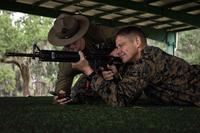 The U.S. Defense Department has canceled development of an alternative helmet for the F-35 fighter jet, the program office announced today.
The U.S. Defense Department has canceled development of an alternative helmet for the F-35 fighter jet, the program office announced today.
The move is projected to save about $45 million in avoided development costs, according to Joe DellaVedova, a spokesman for the program.
"The F-35 Joint Program Office (JPO) has decided to stop the development of an alternate helmet and focus solely on bringing the 'Gen 2' helmet – now being used in testing and training – up to a fully compliant Gen 3 standard," he said in an e-mailed statement.
The decision is a loss for BAE Systems Inc., the U.S. subsidiary of London-based BAE Systems Plc, which was developing the product in coordination with the plane's manufacturer, Lockheed Martin Corp.
“We are disappointed at today’s decision by Lockheed Martin and the Joint Strike Fighter Joint Program Office to discontinue the pursuit of a second helmet for the F-35 aircraft," Liz Ryan Sax, a spokeswoman for the company's Electronic Systems unit, said in an e-mail. The team "has achieved every milestone to date, providing a critical viable alternative for the customer," she said.
The Pentagon in September 2011 tapped BAE Systems to build a more traditional fighter helmet with night-vision goggles after Lockheed, Rockwell Collins Inc. and Elbit Systems Ltd. encountered problems developing a more advanced design, known as the Helmet Mounted Display System.
The dual-approach helped to lower the cost of the display system by 12 percent, DellaVedova said, though he didn't specify its latest price tag.
The Helmet Mounted Display System is supposed to provide fighter pilots with 360-degree situational awareness in any kind of weather, day or night. The jet's distributed aperture system is designed to stream real-time imagery from cameras mounted around the aircraft to the helmet, allowing pilot's to "see through" the air frame.
While development of the technology "has posed significant challenges," the program office has worked with Lockheed over the past two years to identify fixes, DellaVedova said.
"Improvements to the Gen 2 helmet are planned and being phased into production," he said.
The second-generation helmet that pilots currently use will meet the needs for the Marine Corps to begin operational flights of the F-35 in July 2015, DellaVedova said.
The third-generation helmet -- including an improved night-vision camera, new liquid-crystal displays, automated alignment and software improvements -- will be introduced in 2016 as part of the seventh batch of Lightning II aircraft, DellaVedova said.
The Marine Corps version of the jet, called the F-35B, which can fly like a plane and land like a helicopter, is scheduled to begin operational flights by December 2015; the Air Force’s conventional version by December 2016 and the Navy’s carrier variant by February 2019.
The F-35 Joint Strike Fighter program is the Pentagon's most expensive weapons systems, estimated to cost $391 billion to develop and build 2,457 aircraft.
"The government's decision to proceed exclusively with the principle helmet is indicative of their confidence in the helmet's performance and the successful resolution of previously identified technical challenges," Lorraine Martin, Lockheed Martin executive vice president and general manager of the F-35 Lightning II Program, said in a statement.







